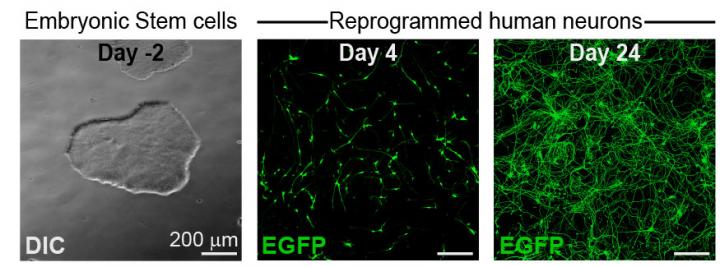A tool for probing genetic and molecular underpinnings of drug-induced neurodevelopmental disorders

Credit: Soham Chanda/Colorado State University
Pregnant women are often advised to avoid certain drugs because of potential risks to their unborn infant’s growing brain cells. Such risks are difficult to pinpoint, though, because there are few ways to track the cellular mechanisms of a drug while the fetus is developing.
Soham Chanda, an assistant professor in the Department of Biochemistry and Molecular Biology, has designed a new experimental system that can rapidly assess the pathogenic effects of a drug on a baby’s developing brain. His system uses embryonic stem cells reprogrammed into neurons, offering a powerful tool for probing genetic and molecular underpinnings of drug-induced neurodevelopmental disorders. The knowledge gained from this new method could be harnessed to uncover unknown drug risks, as well as preventive therapies.
The research is published in Cell Stem Cell, and the work was primarily carried out while Chanda was a postdoctoral researcher at Stanford University with Thomas Südhof and Marius Wernig. Chanda joined the Colorado State University faculty in January and is continuing to devise methods for understanding biochemical properties of early-stage neuronal development as one of his key research interests.
The paper in Cell Stem Cell describes a model in vitro platform demonstrating the use of reprogrammed stem cells to systematically deconstruct how a drug can disrupt neuronal development. The researchers provided proof-of-concept of their experimental platform by observing the effects of valproic acid, a commonly prescribed drug that treats epileptic seizures and is also associated with fetal brain issues.
Chanda explained that attributing certain phenotypes to different neurodevelopmental stages is extremely challenging in a living (in vivo) system. That’s because during normal development, neurons don’t all generate in lockstep at the same time; thus it’s difficult to distinguish between a developing vs. mature neuron.
But with Chanda’s reprogrammed stem cells, the entire neuronal population is “phase-locked” in early development stages, gradually becoming mature in a synchronous manner. “This gives you a great advantage so that when you expose them to teratogenic drugs, you see the clear effects at early vs. late maturation stages,” Chanda said. Teratogenic drugs are any that disturb the development of an embryo or fetus.
Using this system, the researchers definitively showed that valproic acid has profoundly divergent effects on early- vs. late-stage neuronal development. When neurons were still immature, the drug exposure induced changes in gene expression that led to severe impairments in how the brain cells were shaped, and how they functioned. In particular, they found that these pathogenic effects were largely mediated by a reduced cellular level of the MARCKSL1 protein, which is essential for guiding the structural maturation of newly born neurons. The drug caused no ill effects in mature neurons.
Chanda said his chief aim with the project was to test the efficacy of reprogrammed neurons as an in vitro model for human neurodevelopment, and to prepare this platform to test cellular effects of many different drugs and their consequences.
“Our major goal is to understand the fundamental mechanisms of how neurons develop their morphological and functional properties, and how different molecules contribute to this process,” Chanda said.
###
Link to paper: https:/
Media Contact
Anne Manning
[email protected]
Original Source
https:/
Related Journal Article
http://dx.




